Gangaur Festival: A Celebration of Love, Devotion, and Femininity

Introduction
The Gangaur Festival is one of Rajasthan’s most cherished cultural traditions, deeply rooted in love, devotion, and femininity. Celebrated mainly by women, this vibrant festival honors Goddess Gauri (Parvati), the embodiment of marital bliss, strength, and purity. It also signifies the sacred bond between Lord Shiva and Goddess Parvati.
The Significance Behind the Name ‘Gangaur’
The name Gangaur Festival is derived from the combination of “Gana” (a synonym for Lord Shiva) and “Gauri” (another name for Goddess Parvati). Together, they symbolize divine love and union, making the festival a tribute to enduring relationships and feminine grace.
Historical Background of Gangaur Festival
Mythological Origins
The origins of the Gangaur Festival are steeped in ancient Hindu mythology. Legend has it that Goddess Parvati underwent severe repentance in order to win Lord Shiva’s affection. Her deep devotion and love are what women seek to emulate during the celebration of this sacred event.
Historical Evolution Over Time
From its beginnings in the rural parts of Rajasthan, the Gangaur Festival evolved with royal patronage. Rajput queens played a major role in formalizing the rituals and making it a prominent part of the cultural calendar.
When is Gangaur Festival Celebrated?
Dates and Timing as per Hindu Calendar
The Gangaur Festival begins the day after Holi and is celebrated for 18 days in the month of Chaitra (March–April). This marks the start of spring and symbolizes new beginnings.
Duration of the Festival
During these 18 days, women observe fasts, participate in prayers, sing traditional songs, and perform rituals—all in honor of Goddess Gauri.
The Cultural Importance of Gangaur Festival
Symbolism of Love and Marriage
The Gangaur Festival is a beautiful reflection of Indian marital ideals. It celebrates not just marriage but the emotional strength, patience, and unconditional love that define a woman’s role in it.
Empowerment of Women Through Rituals
Beyond marriage, the Gangaur Festival offers women a chance to celebrate their identity, express artistic creativity, and connect spiritually through devotion and community participation.
Rituals and Customs During Gangaur Festival
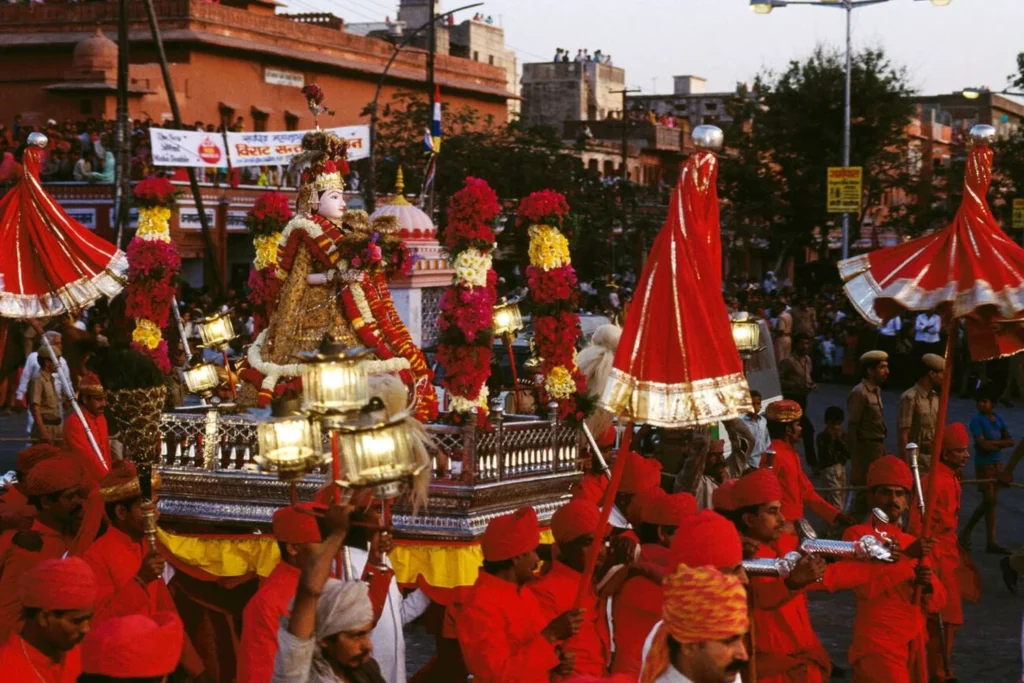
Worship of Lord Shiva and Goddess Gauri
The celebration of Lord Shiva and Goddess Gauri is at the center of the Gangaur Festival. Women create clay idols of the divine couple, decorate them with flowers and traditional attire, and offer prayers daily.
The Making of Clay Idols
These idols are handmade by women and girls using clay or wood. Making the idols is an act of devotion and artistry, and it sets the tone for the rest of the Gangaur Festival.
Dressing Up and Mehendi Ceremony
A key tradition during the Gangaur Festival is women dressing in vibrant Rajasthani attire and adorning their hands with mehendi. This symbolizes prosperity and is believed to bring blessings.
Traditional Songs and Folk Dances
Gangaur Geet, which are devotional songs that have been passed down through the generations, and folk dances are performed by groups of women every evening to add rhythm and joy to the celebrations.
Regional Variations of Gangaur Festival
Jaipur’s Royal Procession
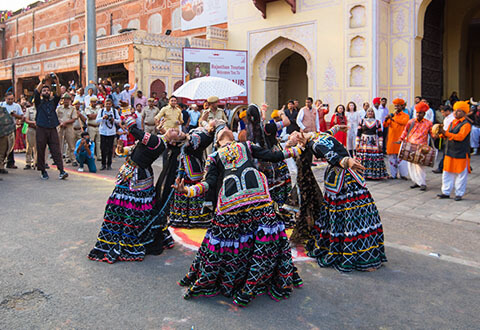
In Jaipur, the Gangaur Festival is celebrated with grandeur. The streets are lined with a magnificent procession that includes decorated idols, camels, and royal chariots.
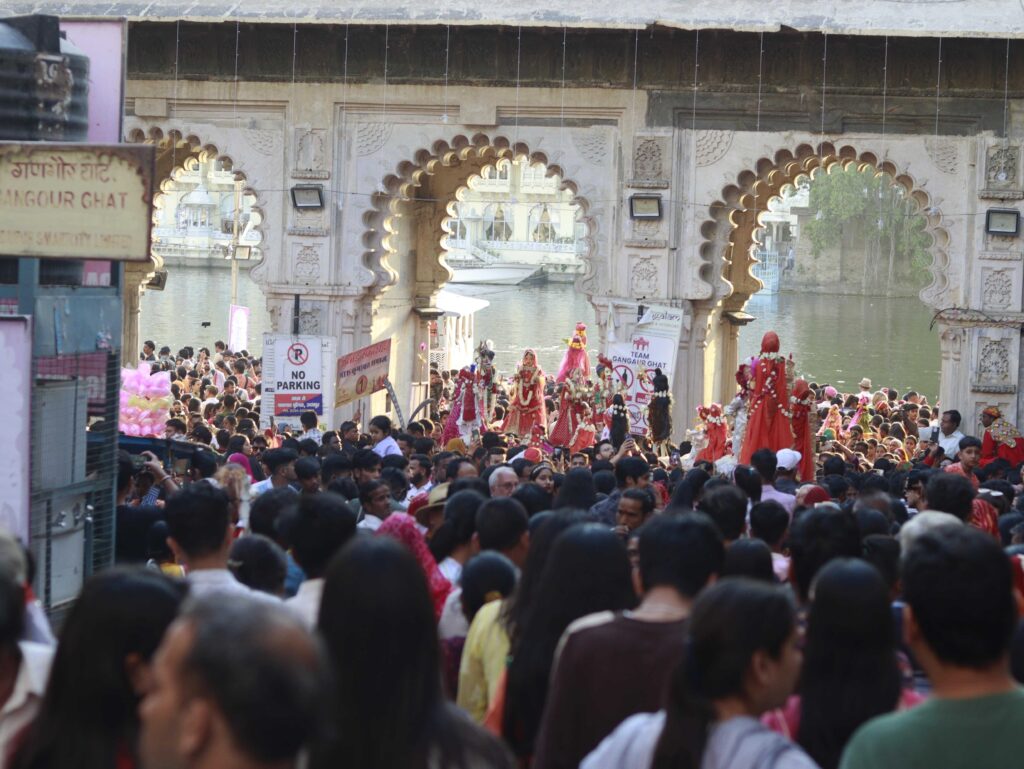
Udaipur’s Boat Procession
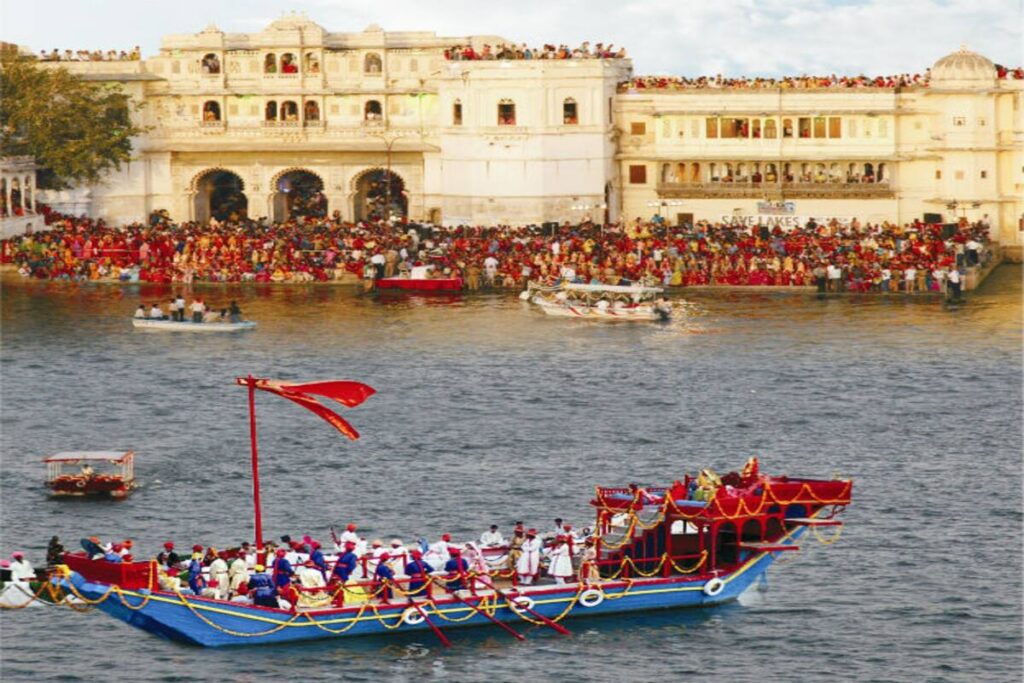
Udaipur adds its own charm by hosting a boat procession on Lake Pichola. The serene water, lit lamps, and traditional music make this version of the Gangaur Festival unforgettable.
Rural Rajasthan’s Simpler Celebrations
In the villages, the Gangaur Festival is observed with simple, heartfelt rituals. Devotion, camaraderie, and the upholding of cherished traditions continue to be the main themes.
Role of Women in Gangaur Festival
Unmarried Girls’ Prayers for Ideal Husbands
One of the primary rituals of the Gangaur Festival is unmarried girls fasting and praying for a life partner like Lord Shiva—faithful, loving, and strong.
Married Women Seeking Marital Bliss
Using the Gangaur Festival as a time to reaffirm their marriage vows through devotion, married women pray for their husbands’ health, longevity, and success.
Festive Foods and Offerings
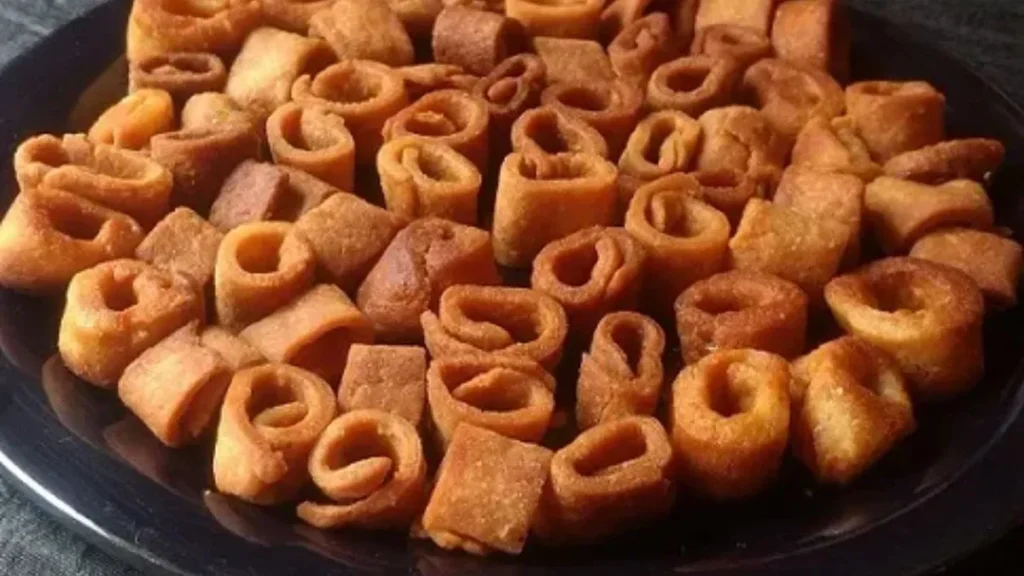
Special Dishes Prepared During Gangaur
Food is an essential part of the Gangaur Festival. Traditional sweets like ghewar, kheech, malpua, and badam halwa are prepared and shared among family and neighbors.
Offerings Made to the Deities
Offerings of fruits, sweets, wheat grass, and sacred water are placed before the idols of Gauri and Shiva. These rituals symbolize abundance, love, and fertility.
Traditional Attire and Ornaments
Women’s Ethnic Dresses
During the Gangaur Festival, women wear ghagras, odhnis, and blouses adorned with traditional embroidery, mirror work, and bandhani prints.
Use of Jewelry and Makeup
Ornaments like borlas, bajubandh, and heavy bangles are worn with pride. The extravagant attire reflects the festival’s celebratory atmosphere.
Songs and Stories Shared During Gangaur Festival
Folk Tales of Gauri and Shiva
During the Gangaur Festival, tales of Goddess Gauri’s unwavering devotion are narrated. These folk stories serve both as spiritual lessons and as cultural storytelling traditions.
Songs Passed Down Through Generations
Songs by women, such as “Kesariya Balam” and “Gangaur Aayo,” touch on love, devotion, and the divine feminine power.
Modern-Day Celebrations
Influence of Urbanization
With changing times, the Gangaur Festival has embraced modern elements—like photography contests, cultural fairs, and social media campaigns—without losing its core values.
Gangaur in Contemporary Society
Even in modern urban settings, the Gangaur Festival remains relevant as a symbol of cultural pride, familial unity, and feminine strength.
Gangaur Festival and Tourism
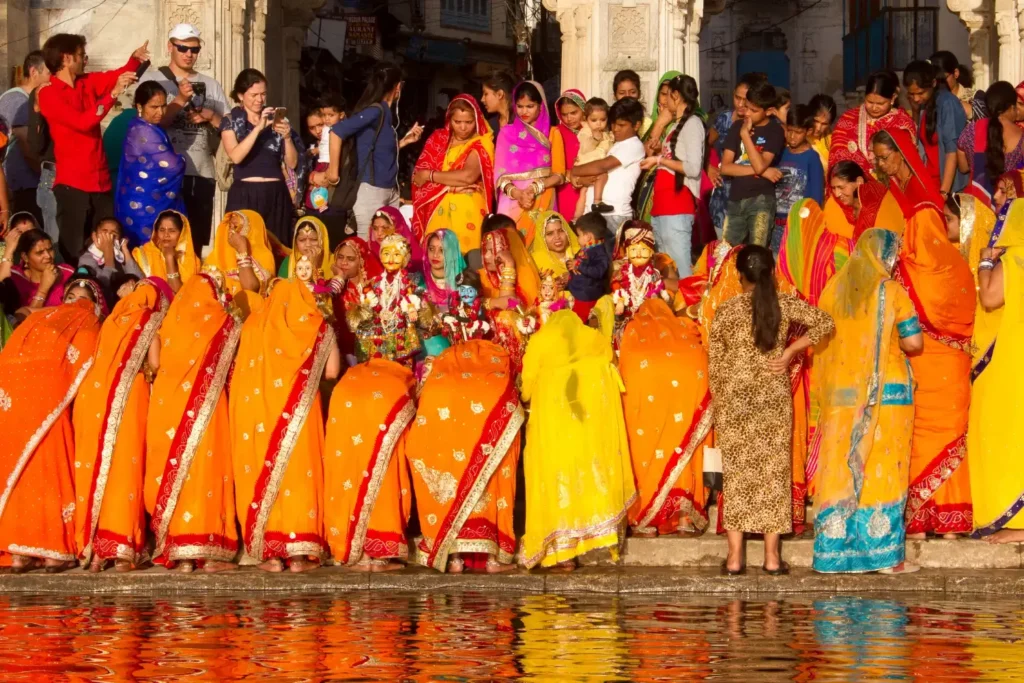
Attraction for International Tourists
Thanks to its color, music, and authentic charm, the Gangaur Festival has become a major tourist attraction. Visitors from around the world experience the culture of Rajasthan through it.
Contribution to Rajasthan’s Cultural Identity
The Gangaur Festival plays a vital role in shaping and showcasing Rajasthan’s unique identity to the rest of India and the world.
Environmental and Social Impact
Eco-Friendly Celebrations
In recent years, the focus of the Gangaur Festival has shifted toward sustainable practices. Natural clay and biodegradable materials are encouraged.
Women’s Social Gatherings and Community Bonding
The Gangaur Festival strengthens social bonds, allowing women to gather, share, celebrate, and uplift one another in a joyous environment.
Preservation of Gangaur Traditions
Role of Schools and Cultural Societies
Schools and cultural organizations now hold Gangaur Festival awareness programs, ensuring that children understand its significance and continue the traditions.
Youth Participation in Keeping the Festival Alive
With workshops, online content, and active social participation, the younger generation is keeping the spirit of the Gangaur Festival alive and well.
Conclusion
The Gangaur Festival is an amazing celebration of womanhood, culture, and devotion. It’s not just about rituals—it’s a profound celebration of love, strength, and community. Whether it’s a royal procession in Jaipur or a humble village gathering, the soul of the Gangaur Festival continues to shine brightly. Rooted in mythology yet thriving in the modern world, this festival is truly a jewel in Rajasthan’s cultural crown.
FAQs
1. What is Gangaur Festival and why is it celebrated?
The Gangaur Festival honors Goddess Gauri and celebrates love, marriage, and womanhood. It is observed primarily by women across Rajasthan.
2. How long is the Gangaur Festival?
The Gangaur Festival lasts for 18 days starting the day after Holi, during the Hindu month of Chaitra.
3. Who can celebrate Gangaur Festival?
Both married and unmarried women celebrate the Gangaur Festival, each with distinct rituals focused on love and devotion.
4. What food is prepared during Gangaur Festival?
Popular dishes include ghewar, kheech, and malpua, along with offerings made to Goddess Gauri.
5. Where can I experience the best Gangaur Festival celebrations?
Jaipur and Udaipur are known for the most vibrant and royal Gangaur Festival celebrations, drawing large crowds and tourists.